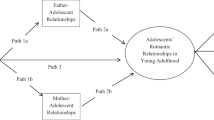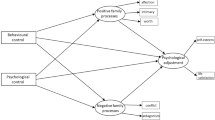Abstract
Although parent-adolescent interactions have been examined, relevant variables have not been integrated into a multivariate model. As a result, this study examined a multivariate model of parent-late adolescent gender dyads in an attempt to capture important predictors in late adolescents’ important and unique transition to adulthood. The sample for this study consisted of 151 male and 324 female late adolescents, who reported on their mothers’ and fathers’ parenting style, their family environment, their mothers’ and fathers’ expectations for them, the conflict that they experience with their mothers and fathers, and their own adjustment. Overall, the variables had significant relationships with one another. Further, the male-father, male-mother, and female-father structural equation models that were examined suggested that parenting style has an indirect relationship with late adolescents’ adjustment through characteristics of the family environment and the conflict that is experienced in families; such findings were not evident for the female-mother model. Thus, the examination of parent-late adolescent interactions should occur in the context of the gender of parents and their late adolescents.
Similar content being viewed by others
References
Dekovic M (1999) Parent-adolescent conflict: possible determinants and consequences. Int J Behav Dev 23:977–1000
Noack P, Puschner B (1999) Differential trajectories of parent-child relationships and psychosocial adjustment in adolescents. J Adolesc 22:795–804
Arnett JJ (1999) Adolescent storm and stress, reconsidered. Am Psychol 54:317–326
Holmbeck GN (1996) A model of family relational transformations during the transition to adolescence: Parent-adolescent conflict and adaptation. In: Graber JA, Brooks-Gunn J (eds) Transitions through adolescence: interpersonal domains and context. Lawrence Erlbaum Associates, Hillsdale NJ, pp 167–199
Hofer M, Youniss J, Noack P (1998) Verbal interaction and development in families with adolescents. In: Hofer M, Youniss J, Noack P (eds) Verbal interaction and development in families with adolescents. Ablex Publishing, Westport CT, pp 1–10
Noack P, Kracke B (1998) Continuity and change in family interactions across adolescence. In: Hofer M, Youniss J, Noack P (eds) Verbal interaction and development in families with adolescents. Ablex Publishing, Westport CT, pp 65–81
Brooks-Gunn J, Zahaykevich M (1989) Parent-daughter relationships in early adolescence: A developmental perspective. In: Kreppner K, Lerner RM (eds) Family systems and life-span development. Lawrence Erlbaum Associates, Hillsdale NJ, pp 223–246
Steinberg L (1990) Interdependence in the family: Autonomy, conflict, and harmony in the parent-adolescent relationship. In: Feldman SS, Elliot GL (eds) At the threshold: The developing adolescent. Harvard University Press, Cambridge MA, pp 255–276
Smetana JG (1996) Adolescent-parent conflict: implications for adaptive and maladaptive development. In: Cicchetti D, Toth SL (eds) Adolescence: opportunities and challenges. University of Rochester Press, Rochester NY, pp 1–46
Laursen B, Collins WA (1994) Interpersonal conflict during adolescence. Psychol Bull 115:197–209
Allen JP, Land D (1999). Attachment in adolescence. In: Cassidy J, Shaver PR (eds) Handbook of attachment: theory, research, and clinical applications. Guilford Press, New York, pp 319–335
Arnett JJ (2000) Emerging adulthood: a theory of development from the late teen through the twenties. Am Psychol 55:469–480
Baumrind D (1991) Effective parenting during the early adolescent transition. In: Cowan PA (eds) Family transitions. Lawrence Erlbaum Associates, Hillsdale NJ, pp 111–163
Bosco GL, Renk K, Dinger TM, Epstein MK, Phares V (2003) The connections between adolescents’ perceptions of parents, parental psychological symptoms, and adolescent functioning. J Appl Dev Psychol 24:179–200
Holmbeck GN, Paikoff RL, Brooks-Gunn J (1995) Parenting adolescents. In: Bornstein MH (eds) Handbook of parenting. Lawrence Erlbaum Associates, Mahwah NJ, pp 91–118
Paulson SE, Sputa CL (1996) Patterns of parenting during adolescence: Perceptions of adolescents and parents. Adolescence 31:369–381
Sim TN (2003) The father-adolescent relationship in the context of the mother-adolescent relationship: exploring moderating linkages in a late-adolescent sample in Singapore. J Adolesc Res 18:383–404
McBride HA, Mills G (1993) A comparison of mother and father involvement with their preschool age children. Early Child Res Q 8:457–477
Pleck JH (1997) Paternal involvement: Levels, sources, and consequences. In: Lamb ME (eds) The role of the father in child development. Wiley, New York, pp 66–103
Renk K, Roberts R, Roddenberry A, Luick M, Hillhouse S, Meehan C, Oliveros A, Phares V (2003) Mothers, fathers, gender role, and time parents spend with their children. Sex Roles 48:305–315
Renk K, Liljequist L, Simpson J, Phares V (2005) Gender and age differences in the topics of parent-adolescent conflict. The Fam J 13:139–149
Conrade G, Ho R (2001) Differential parenting styles for fathers and mothers: Differential treatment for sons and daughters. Aust J Psychol 53:29–35
Phares V (1999) “Poppa” psychology. Praeger Publishers, Westport CT
Ross RD, Marrinan S, Schattner S, Gullone E (1999) The relationship between perceived family environment and psychological wellbeing: mother, father, and adolescent reports. Aust Psychol 34:58–63
Rueter MA, Conger RD (1995) Antecedents of parent-adolescent disagreements. J Marriage Fam 57:435–448
Dekovic M, Noom MJ, Meeus W (1997) Expectations regarding development during adolescence: parental and adolescent perceptions. J Youth Adolesc 26:253–272
Collins WA, Luebker C (1994) Parent and adolescent expectancies: individual and relational significance. In: Smetana JG (eds) Beliefs about parenting: origins and developmental implications. Jossey-Bass/Pfeiffer, San Francisco CA, pp 65–80
Renk K, Roddenberry A, Oliveros A, Roberts R, Meehan C, Liljequist L (2006) An examination of conflict in emerging adulthood between college students and their parents. J Intergen Relat 4:41–59
Dyson R, Renk K (2006) Freshmen adaptation to university life: depressive symptoms, stress, and coping. J Clin Psychol 62:1231–1244
Fisher S, Hood BM (1987) The stress of the transition to university: a longitudinal study of psychological disturbance, absent-mindedness and vulnerability to homesickness. Br J Psychol 78:425–411
Blimling GS, Miltenberg LJ (1981) The resident assistant: working with college students in residence halls (Second edition). Kendall/Hunt, Dubuque IA
Noom M, Dekovic M (1998) Family interaction as a context for the development of adolescent autonomy. In: Hofer M, Youniss J, Noack P (eds) Verbal interaction and development in families with adolescents. Ablex Publishing, Westport CT, pp 109–125
Parker G, Tupling H, Brown LB (1979) A parental bonding instrument. Br J Med Psychol 52:1–10
Buri JR (1991) Parental authority questionnaire. J Pers Assess 57:110–119
Anderson SA, Sabatelli RM (1992) The differentiation in the family system scale. The Am J Fam Ther 20:77–89
Bloom BL (1985) A factor analysis of self-report measures of family functioning. Fam Process 24:225–239
Olson DH, Bell R, Portner J (1992) Family inventories manual. Life Innovations, Minneapolis MN
Straus MA, Hamby SL, Finkelhor D, Moore DW, Runyan D (1998) Identification of child maltreatment with the parent-child conflict tactics scales: development and psychometric data for a national sample of American parents. Child Abuse Negl 22:249–270
Beck AT, Steer RA, Brown GK (1996) Beck depression inventory, 2nd edn. Manual. The Psychological Corporation, San Antonio TX
Taylor JA (1953) A personality scale of manifest anxiety. The J Abnorm Soc Psychol 48:285–290
Rosenberg M (1965) Society and the adolescent self image. Princeton University Press, Princeton NJ
Kline RB (1998) Principles and practice of structural equation modeling. The Guilford Press, New York
Bentler PM (1992) On the fit of models to covariances and methodology to the Bulletin. Psychol Bull 112:400–404
James LR, Mulaik SS, Brett JM (1982) Causal analysis: assumptions, models, and data. Sage Publications, Beverly Hills CA
Anderson JC, Gerbing DW (1988) Structural equations modeling in practice: a review and recommended two-step approach. Psychol Bull 103:411–423
Kanter Agliata A, Renk K College students’ adjustment: the role of parent-college student expectation discrepancies and communication reciprocity. J Youth Adolesc (in press)
Anderson W, Yuenger C (1987) Parents as a source of stress for college students. Coll Student J␣21:317–323
Archer J, Lamnin A (1985) An investigation of personal and academic stressors on college campuses. J␣Coll Student Pers 26:210–215
Acknowledgement
Special thanks to Jack McGuire, Ph.D., and Valerie Sims, Ph.D., for reviewing previous versions of this manuscript.
Author information
Authors and Affiliations
Corresponding author
Rights and permissions
About this article
Cite this article
McKinney, C., Renk, K. Multivariate Models of Parent-Late Adolescent Gender Dyads: The Importance of Parenting Processes in Predicting Adjustment. Child Psychiatry Hum Dev 39, 147–170 (2008). https://doi.org/10.1007/s10578-007-0078-1
Received:
Accepted:
Published:
Issue Date:
DOI: https://doi.org/10.1007/s10578-007-0078-1




